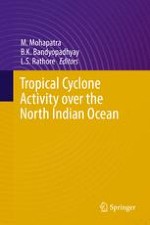The Indian sub-continent is one of the most adversely affected TC active basins that experience on an average 4–5 TCs every year. In comparison to other TC basins, this region is the most vulnerable due to relatively dense coastal population, shallow bottom topography and coastal configuration. Though the TCs formed in this region are considered to be much weaker in intensity and smaller in size as compared to other region, yet the number of deaths in the region is highest in the globe (300,000 human deaths were estimated from TC associated storm surge in Bangladesh in 1970). Out of nine recorded cases of heavy loss of human lives (~40,000) by TCs during last 300 years, seven cases (77 %) occurred in Indian sub-continent (Frank and Hussain, Bull Amer Meteor Soc 52:438–445, 1971). To overcome such loss, the advance predictions of TC in terms of their genesis, track and intensity is highly important. These advance timely information can save the life of people and help in decision making for taking the preventive measures like evacuation during the TC landfall. The predictions of TC are generated based on the models, using the satellite observations and ground based radar networks when TC reaches close to the land (Mohapatra et al., J Earth Syst Sci 122:433–451. doi:
10.1007/s12040-013-0291-1, 2013a). Due to the advancements in numerical prediction models and, high temporal and spatial satellite observations, during the last decades the track prediction accuracy has been improved drastically (Mohapatra et al., Nat Hazards 68:589–601. doi:
10.1007/s11069-013-0624-z, 2013b; J Earth Syst Sci 124:861–874. doi:
10.1007/s12040-015-0581-x, 2015). However, the predictions of TC genesis and intensity are still challenging as in TC predictions (Mohapatra et al., Mausam 61:1–15, 2013c), the requirements of accuracy in genesis, track and intensity are higher compared to normal numerical weather predictions. Skillful prediction of tropical cyclogenesis will be of great benefit for the affected communities as it may provide sufficient time for planning and preparations (e.g. Brunet, Bull Amer Meteorol Soc 91:1397–1406, 2010). Due to unavailability of conventional observations, satellite data are being employed and found to be useful tool to study and understand tropical cyclogenesis (Liu et al., Meteorol Atmos Phys 56:111–123, 1995; Zehr, Satellite diagnosis of tropical cyclones. In: Proceedings of 3rd conference on satellite meteorology and oceanography, Anaheim, CA, pp 241–246, 1998; Katsaros et al., Geophys Res Lett 28:1043–1046, 2001; Sharp et al., Bull Amer Meteorol Soc 83:879–889, 2002; Li et al., Geophys Res Lett 30:2122, 2003; Chelton et al., Science 303:978–983, 2004; Wang et al., Tellus (Ser. A) 59:562–569, 2007; Geophys Res Lett 35:1–5, 2008). The microwave scatterometers onboard polar-orbiting satellites have helped to study the early stages of cyclogenesis (Sharp et al., Bull Amer Meteorol Soc 83:879–889, 2002). Sea-winds scatterometer, aboard the QuikScat satellite that infers surface wind speed and direction, has encouraged various studies regarding early identification of tropical disturbances (Sharp et al., Bull Amer Meteorol Soc 83:879–889, 2002; Li et al., Geophys Res Lett 30:2122, 2003). The wind pattern matching based technique using scatterometer derived surface wind have been discussed by Jaiswal and Kishtawal (IEEE Trans Geosci Remote Sens 49:4904–4909, 2011) and Jaiswal et al., Meteorol Atmos Phys 119:137–149, 2013. The above technique depends on the availability of coverage of the cyclonic disturbance during the satellite overpass. In the present study, the cyclogenesis prediction of the systems formed during year 2013 has been discussed using the OSCAT derived surface wind vector based cyclogenesis prediction algorithm. The brief methodology is provided in Sect.
2. The results are discussed in the Sect.
3 and the conclusions of the study are given in Sect.
4.
